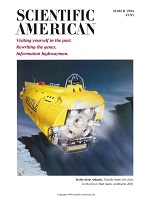|  | | | | 

| | The Quantum Physics of Time Travel
by David Deutsch and Michael Lockwood
First publication: Scientific American, Mar 1994

I propose that all writers of time travel fiction should be required to read certain articles, and this is the first. Deutsch and Lockwood do an admirable job of describing the well-known Grandfather Paradox and the lesser known paradox of the causal loop (in which, for example, an art critic brings a book of famous paintings back to the artist before the time when the paintings were painted, and this book then inspires those very paintings, leaving the question of who created the paintings).

The article then tries to unwind these paradoxes in classical physics, where there is but one universe. In this universe, a time traveler who returns to the past can do nothing except that which was already done. For example, the traveler simply cannot kill his or her own grandfather before Grandpa meets Grandma because we know (by the birth of the traveler) that that didn’t happen. So, something in the universe must stop the murder. Things must happen as they happened.

But, say Deutsch and Lockwood, this conspiracy of the universe to preserve consistency violates the Autonomy Principle, according to which “it is possible to create in our immediate environment any configuration of matter that the laws of physics permit locally, without reference to what the rest of the universe may be doing.” In other words, if it’s physically possible for the traveler to point a gun at Grandpa, then the fact that elsewhen in the universe Grandpa must knock up Grandma cannot interfere with the traveler’s ability to pull the trigger.

Deutsch and Lockwood use the Autonomy Principle to reject something, but it’s classical physics they reject, not time travel. In a similar way, for stories that rely on a Causal Loop Paradox, Deutsch and Lockwood ask: Just where did the original idea of the paintings come from? They reject that the paintings might have come from nowhere (TANSTAAFL!), and again they reject classical physics.

Personally, I hope that time travel writers don’t fully embrace the Autonomy Principle and TANSTAAFL, because I want more wonderful stories where, in fact, there is but one history of events, the future and past may both be fixed, free will is an illusion, and free lunches exist. Hooray for “—All You Zombies—”!

But with classical physics banned, what else is there? Deutsch and Lockwood turn to Everett’s Many Worlds model wherein each collapse of the quantum wave function results in a new universe. When a time traveler goes to the past, they say, the arrival of the traveler creates a new multiverse, and this multiverse does not need to act the same as the original. Grandpa can die! The artist can be given inspiration from an artist doppleganger in the original universe!

Noteably, though, Deutsch and Lockwood never discuss how time travel might cause the same kind of universe splitting as the collapse of the wave function, but never mind. What they do discuss is how the new universe must respond to changes, and many stories where changing the past is possible fall down on this account. For example, if you change the past so that the reason for your trip to the past no longer exists, then when you return to the present you should find a new version of yourself who never considered traveling to the past. Multiverse time travelers should read this article just to understand that the present they return to may very well have another versin of themselves. Two Marty McFlies!

One final note: Of course we don’t live in a classical physics universe. That's clear from the many experiments that support quantum physics. But living in a quantum world doesn’t immediately imply Many Worlds. Could time travel exist in a single quantum universe? Or does it? For thoughts on that, check out the online “Scientific American article “Time Travel Simulation Resolves Grandfather Paradox” by Lee Billings. In the art critic story, quantum mechanics allows events, from the participants’ perspective, to occur much as Dummett describes. The universe that the critic comes from must have been one in which the artist did, eventually, learn to paint well. In that universe, the pictures were produced by creative effort, and reproductions were later taken to the past of another universe. There the paintings were Indeed plagiarized—if one can be said to plagiarize the work of another version of oneself—and the painter did get \“some- thing for nothing.” But there is no para- dox, because now the existence of the pictures was caused by genuine creative effort, albeit in another universe. In the art critic story, quantum mechanics allows events, from the participants’ perspective, to occur much as Dummett describes. The universe that the critic comes from must have been one in which the artist did, eventually, learn to paint well. In that universe, the pictures were produced by creative effort, and reproductions were later taken to the past of another universe. There the paintings were Indeed plagiarized—if one can be said to plagiarize the work of another version of oneself—and the painter did get \“some- thing for nothing.” But there is no para- dox, because now the existence of the pictures was caused by genuine creative effort, albeit in another universe. 
| |
| | | | |

| |     |